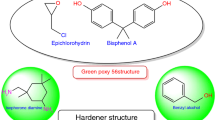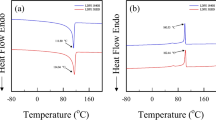Abstract
Asphaltenes tend to aggregate to nanoparticles or clusters in crude oil and solvents over a wide concentration and temperature range. In the present paper, asphaltenes extracted from the base asphalt was used as a filler to introduce into epoxy resin. The microstructure and evolution of asphaltenes aggregation in the epoxy resin were observed using laser scanning confocal microscopy. Furthermore, the effect of asphaltenes on the viscosity, dynamic mechanical behavior, thermostability, mechanical properties of epoxy resin was evaluated by Brookfield rotational viscometer, dynamic mechanical analysis, thermogravimetric analysis and universal testing machine. The presence of asphaltenes increased the viscosity of the neat epoxy during all stages of cure reaction. The viscosity of epoxy/asphaltenes composites increased with the filler concentration. Fractal asphaltenes aggregation formed in the composites with 1 mass% asphaltenes. Network microstructures of asphaltenes aggregation appeared in the epoxy phase with a further increase of asphaltenes content. Moreover, the increase of asphaltenes loading resulted in denser network microstructures in the epoxy matrix. Aggregation evolution revealed that asphaltenes particles redispersed evenly in the epoxy resin in the form of some aggregates at the beginning of curing. During the cure reaction of epoxy, asphaltenes aggregates started to agglomerate and grow to network microstructures. The presence of asphaltenes led to the enhancement of the storage modulus of the neat epoxy at the rubbery stage. The glass transition temperature (Tg) of the epoxy composites slightly increased with the increase of asphaltenes loading. The epoxy composite with 5 mass% asphaltenes had higher Tg than the neat epoxy. The inclusion of asphaltenes had a negligible effect on the damping properties and thermal stability of the neat epoxy. The aggregation and heterogeneous dispersion of asphaltenes resulted in the decrease of the tensile strength and elongation at break of the neat epoxy. However, the inclusion of asphaltenes significantly enhanced Young’s modulus of the neat epoxy. Young’s modulus of the neat epoxy was increased by more than fourfold with the addition of 5 mass% asphaltenes.










Similar content being viewed by others
References
Redelius P, Soenen H. Relation between bitumen chemistry and performance. Fuel. 2015;140:34–43.
D’Melo D, Taylor R. Constitution and structure of bitumens. In: Hunter RN, Self A, Read J, editors. The shell bitumen handbook. 6th ed. London: ICE Publishing; 2015. p. 47–63.
Corbett LW. Composition of asphalt based on generic fractionation, using solvent deasphaltening, elution-adsorption chromatography, and densimetric characterization. Anal Chem. 1969;41(4):576–9.
Lesueur D. The colloidal structure of bitumen: consequences on the rheology and on the mechanisms of bitumen modification. Adv Colloid Interf Sci. 2009;145(1–2):42–82.
Speight JG. Petroleum asphaltenes—Part 1: asphaltenes, resins and the structure of petroleum. Oil Gas Sci Technol. 2004;59(5):467–77.
Calandra P, Caputo P, De Santo MP, Todaro L, Turco Liveri V, Oliviero RC. Effect of additives on the structural organization of asphaltene aggregates in bitumen. Constr Build Mater. 2019;199:288–97.
Ghosh AK, Chaudhuri P, Kumar B, Panja SS. Review on aggregation of asphaltene vis-a-vis spectroscopic studies. Fuel. 2016;185:541–54.
Vargas FM, Tavakkoli M. Asphaltene deposition: fundamentals, prediction, prevention, and remediation. Boca Raton: CRC Press; 2018.
Wu H, Kessler MR. Asphaltene: structural characterization, molecular functionalization, and application as a low-cost filler in epoxy composites. RSC Adv. 2015;5(31):24264–73.
Wu H, Thakur VK, Kessler MR. Novel low-cost hybrid composites from asphaltene/SBS tri-block copolymer with improved thermal and mechanical properties. J Mater Sci. 2016;51(5):2394–403.
Siddiqui MN. Studies of different properties of polystyrene-asphaltene composites. Macromol Symp. 2015;354(1):184–90.
Siddiqui MN. Using asphaltenes as filler in methyl methacrylate. Polym Compos Petrol Sci Technol. 2016;34(3):253–9.
Siddiqui MN. Preparation and properties of polypropylene-asphaltene composites. Polym Compos. 2017;38(9):1957–63.
Siddiqui MN, Redhwi HH, Younas M, Alghizzi AG, Suliman MH, Achilias DS. Effect of natural macromolecule filler on the properties of high-density polyethylene (HDPE). Macromol Symp. 2018;380(1):1800072.
Siddiqui MN, Redhwi HH, Younas M, Hussain S, Achilias DS. Use of asphaltene filler to improve low-density polyethylene properties. Petrol Sci Technol. 2018;36(11):756–64.
Zhang Y, Pan X, Sun Y, Xu W, Pan Y, Xie H, et al. Flame retardancy, thermal, and mechanical properties of mixed flame retardant modified epoxy asphalt binders. Constr Build Mater. 2014;68:62–7.
Sun Y, Zhang Y, Xu K, Xu W, Yu D, Zhu L, et al. Thermal, mechanical properties, and low-temperature performance of fibrous nanoclay-reinforced epoxy asphalt composites and their concretes. J Appl Polym Sci. 2015;132(12):41694.
Liu Y, Zhang J, Chen R, Cai J, Xi Z, Xie H. Ethylene vinyl acetate copolymer modified epoxy asphalt binders: phase separation evolution and mechanical properties. Constr Build Mater. 2017;137:55–65.
Su W, Han X, Gong J, Xi Z, Zhang J, Wang Q, et al. Toughening epoxy asphalt binder using core-shell rubber nanoparticles. Constr Build Mater. 2020;258:119716.
Zhang J, Su W, Liu Y, Gong J, Xi Z, Zhang J, et al. Laboratory investigation on the microstructure and performance of SBS modified epoxy asphalt binder. Constr Build Mater. 2021;270:121378.
Sun Y, Liu Y, Jiang Y, Xu K, Xi Z, Xie H. Thermal and mechanical properties of natural fibrous nanoclay reinforced epoxy asphalt adhesives. Int J Adhes Adhes. 2018;85:308–14.
Sun Y, Han X, Su W, Gong J, Xi Z, Zhang J, et al. Mechanical and bonding properties of pristine montmorillonite reinforced epoxy asphalt bond coats. Polym Compos. 2020;41(8):3034–42.
Sun Y, Liu Y, Gong J, Han X, Xi Z, Zhang J, et al. Thermal and bonding properties of epoxy asphalt bond coats. J Therm Anal Calorim. 2021. https://doi.org/10.1007/s10973-021-10630-8.
Gong J, Han X, Su W, Xi Z, Cai J, Wang Q, et al. Laboratory evaluation of warm-mix epoxy SBS modified asphalt binders containing Sasobit. J Build Eng. 2020;32:101550.
Liu Y, Zhang J, Jiang Y, Li C, Xi Z, Cai J, et al. Investigation of secondary phase separation and mechanical properties of epoxy SBS-modified asphalts. Constr Build Mater. 2018;165:163–72.
Yin H, Jin H, Wang C, Sun Y, Yuan Z, Xie H, et al. Thermal, damping, and mechanical properties of thermosetting epoxy-modified asphalts. J Therm Anal Calorim. 2014;115(2):1073–80.
Gong J, Liu Y, Wang Q, Xi Z, Cai J, Ding G, et al. Performance evaluation of warm mix asphalt additive modified epoxy asphalt rubbers. Constr Build Mater. 2019;204:288–95.
Li C, Han X, Gong J, Su W, Xi Z, Zhang J, et al. Impact of waste cooking oil on the viscosity, microstructure and mechanical performance of warm-mix epoxy asphalt binder. Constr Build Mater. 2020;251:118994.
Sun Y, Gong J, Liu Y, Jiang Y, Xi Z, Cai J, et al. Viscous, damping, and mechanical properties of epoxy asphalt adhesives containing different penetration-grade asphalts. J Appl Polym Sci. 2019;136(5):47027.
Koots JA, Speight JG. Relation of petroleum resins to asphaltenes. Fuel. 1975;54(3):179–84.
Liu Y, Xi Z, Cai J, Xie H. Laboratory investigation of the properties of epoxy asphalt rubber (EAR). Mater Struct. 2017;50(5):219.
ASTM D 4124. Standard test methods for separation of asphalt into four fractions. West Conshohocken, PA, USA: American Society for Testing and Materials; 2001.
Jiang Y, Liu Y, Gong J, Li C, Xi Z, Cai J, et al. Microstructures, thermal and mechanical properties of epoxy asphalt binder modified by SBS containing various styrene-butadiene structures. Mater Struct. 2018;51(4):86.
Luo P, Gu Y. Effects of asphaltene content on the heavy oil viscosity at different temperatures. Fuel. 2007;86(7):1069–78.
Zhang Y, Sun Y, Xu K, Yuan Z, Zhang J, Chen R, et al. Brucite modified epoxy mortar binders: flame retardancy, thermal and mechanical characterization. Constr Build Mater. 2015;93:1089–96.
Chen R, Gong J, Jiang Y, Wang Q, Xi Z, Xie H. Halogen-free flame retarded cold-mix epoxy asphalt binders: rheological, thermal and mechanical characterization. Constr Build Mater. 2018;186:863–70.
Gong J, Liu Y, Jiang Y, Wang Q, Xi Z, Cai J, et al. Performance of epoxy asphalt binder containing warm-mix asphalt additive. Int J Pavement Eng. 2021;22(2):223–32.
Yin H, Zhang Y, Sun Y, Xu W, Yu D, Xie H, et al. Performance of hot mix epoxy asphalt binder and its concrete. Mater Struct. 2015;48(11):3825–35.
Jiang Y, Han X, Gong J, Xi Z, Cai J, Wang Q, et al. Laboratory investigation of epoxy asphalt binder modified by brominated SBS. Constr Build Mater. 2019;228:116733.
Mueller M. Introduction to confocal fluorescence microscopy. 2nd ed. Bellingham, Washington, USA: SPIE Press; 2005.
Oh K, Ring TA, Deo MD. Asphaltene aggregation in organic solvents. J Colloid Interf Sci. 2004;271(1):212–9.
Mullins OC, Sabbah H, Eyssautier J, Pomerantz AE, Barré L, Andrews AB, et al. Advances in asphaltene science and the Yen-Mullins model. Energ Fuel. 2012;26(7):3986–4003.
Goertzen WK, Kessler MR. Dynamic mechanical analysis of carbon/epoxy composites for structural pipeline repair. Compos Part B Eng. 2007;38(1):1–9.
Saba N, Jawaid M, Alothman OY, Paridah MT. A review on dynamic mechanical properties of natural fibre reinforced. Polym Compos Constr Build Mater. 2016;106:149–59.
Ma P-C, Mo S-Y, Tang B-Z, Kim J-K. Dispersion, interfacial interaction and re-agglomeration of functionalized carbon nanotubes in epoxy composites. Carbon. 2010;48(6):1824–34.
Serena Saw WP, Mariatti M. Properties of synthetic diamond and graphene nanoplatelet-filled epoxy thin film composites for electronic applications. J Mater Sci Mater Electron. 2012;23(4):817–24.
Saba N, Paridah MT, Abdan K, Ibrahim NA. Dynamic mechanical properties of oil palm nano filler/kenaf/epoxy hybrid nanocomposites. Constr Build Mater. 2016;124:133–8.
Devi LU, Bhagawan SS, Thomas S. Dynamic mechanical analysis of pineapple leaf/glass hybrid fiber reinforced polyester composites. Polym Compos. 2010;31(6):956–65.
Saba N, Alothman OY, Almutairi Z, Jawaid M. Magnesium hydroxide reinforced kenaf fibers/epoxy hybrid composites: mechanical and thermomechanical properties. Constr Build Mater. 2019;201:138–48.
George SC, Ninan KN, Groeninckx G, Thomas S. Styrene–butadiene rubber/natural rubber blends: morphology, transport behavior, and dynamic mechanical and mechanical properties. J Appl Polym Sci. 2000;78(6):1280–303.
Nassar NN, Hassan A, Pereira-Almao P. Thermogravimetric studies on catalytic effect of metal oxide nanoparticles on asphaltene pyrolysis under inert conditions. J Therm Anal Calorim. 2012;110(3):1327–32.
Sun Y, Xu K, Zhang Y, Zhang J, Chen R, Yuan Z, et al. Organic montmorillonite reinforced epoxy mortar binders. Constr Build Mater. 2016;107:378–84.
Ignatenko VY, Kostyuk AV, Smirnova NM, Antonov SV, Ilyin SO. Asphaltenes as a tackifier for hot-melt adhesives based on the styrene-isoprene-styrene block copolymer. Polym Eng Sci. 2020;60(9):2224–34.
Author information
Authors and Affiliations
Corresponding authors
Additional information
Publisher's Note
Springer Nature remains neutral with regard to jurisdictional claims in published maps and institutional affiliations.
Rights and permissions
About this article
Cite this article
Han, X., Su, W., Gong, J. et al. Microstructure and dynamic mechanical properties epoxy/asphaltene composites. J Therm Anal Calorim 147, 2209–2219 (2022). https://doi.org/10.1007/s10973-021-10689-3
Received:
Accepted:
Published:
Issue Date:
DOI: https://doi.org/10.1007/s10973-021-10689-3




